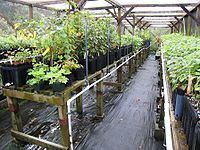Website [2] | ||
 | ||
Organization | ||
Redwood Creek Native Plant Nursery is just outside the old-growth redwood forest at Muir Woods National Monument. The nursery provides plants for restoration of the creek bank in the lower watershed and impacted areas of the Muir Woods’ redwood understory.
Contents
Location
The Redwood Creek watershed extends from the peaks of Mt. Tamalpais, Marin County’s tallest mountain, to the Pacific Ocean and is nestled in one of the nation’s most densely populated regions. This watershed encompasses an area of less than nine square miles, yet it harbors incredibly diverse ecosystems with a rich assemblage of plant and animal species. Within this small watershed are found grasslands, coastal chaparral, mixed hardwood and old-growth redwood forest, seasonal wetlands, and riparian woodlands that extend in an unbroken mosaic from the mountain’s ridge tops to the sea. The watershed is also home to some of the West Coast’s most imperiled species, such as coho salmon (Oncorhyncus kisutch), steelhead trout (O. mykiss), northern spotted owl (Strix occidentalis caurina), and the California red-legged frog (Rana aurora draytonii’’).
The Redwood Creek watershed is 95% public lands and holds Muir Woods National Monument, as well as the communities of Muir Beach and Green Gulch Farm. An indication of its ecological value is that the watershed is one of 25 global biodiversity “hot spots” recognized by the Nature Conservancy and targeted by the global conservation community as key to preserving the world's ecosystem
It is also within the Golden Gate Biosphere Reserve, one of 411 reserves designated by the United Nations Educational, Scientific and Cultural Organization (UNESCO) "Man and the Biosphere" Program to provide a global network representing the world’s major ecosystem types.
Function
The Golden Gate National Parks Conservancy runs five native plant nurseries, which have three main goals:
- Produce high quality container plants for park restoration from local seeds.
- Create and foster a volunteer program.
- Educate community members about concepts of community, ecology, and horticulture.
Redwood Creek Nursery began over 20 years ago, returning native plant communities to trampled areas on the "floor" of Muir Woods. In 1997, the Parks Conservancy began providing professional support in nursery management and restoration through a financial partnership with the Golden Gate National Recreation Area. Since that time, the nursery facility has been upgraded and made more ecologically sensitive. More than 80,000 plants have been grown from seed collected in the Redwood Creek watershed. These have then been planted into the watershed, from the upper slopes of Muir Woods to the mouth of Redwood Creek at Muir Beach.
Recent Restoration Projects
Old Road Removal: It is a priority of the National Park Service to remove roads and pavement wherever possible. Just such a project was accomplished in Muir Woods. By removing a redundant access road to park residences, over an acre of redwood understory habitat was restored.
Muir Woods Trail Decompaction: Until the 1920s, visitors could drive their cars into Muir Woods, and it wasn't until the 1950s that trails began to be officially established in the park. Unrestricted driving and hiking killed most of the understory plants; they also compacted the soil, making it difficult for those species to return on their own. Using hand tools, areas are being decompacted and native plant species reintroduced, helping to restore the Muir Woods plant community.
Lower Redwood Creek Floodplain and Salmon Habitat Enhancement (Banducci): During the last hundred years, farmers and ranchers channelized sections of Redwood Creek and filled in adjoining wetlands. The National Park Service bought out one farm in 1986 and, in 2003, began to restore the creek and its floodplain. Redwood Creek provides the southernmost habitat for the federally listed Coho salmon and Steelhead. Restoring stream processes and revegetation of the stream corridor will provide more useful habitat for these and other species, such as migratory songbirds.
Easkoot Creek: This creek in the Stinson Beach watershed and is also home to the federally listed Coho salmon. The Redwood Creek nursery assists in collecting the seed and growing the native plants which are used in the restoration of this creek.
